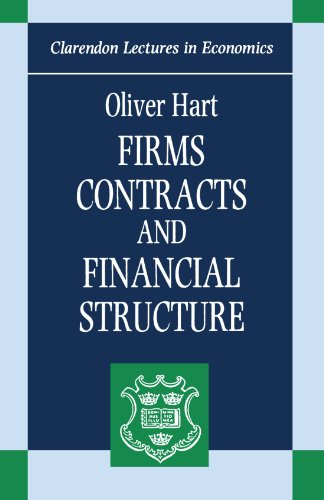Firms, contracts, and financial structure book download
Par shippy shirley le lundi, juin 20 2016, 03:56 - Lien permanent
Firms, contracts, and financial structure. Oliver Hart

Firms.contracts.and.financial.structure.pdf
ISBN: 0198288816,9780198288817 | 239 pages | 6 Mb

Firms, contracts, and financial structure Oliver Hart
Publisher: OUP
This essay contributes to contact theory as it has been developed in economic analysis, particularly in the context of the firm. Regional authorities to restrict the range of activities or structure of banking. For those interested in the economics of contracting: Oliver Hart, Firms, Contracts and Financial Structure (1995). In a footnote on page 5 of his 1995 book "Firms Contracts and Financial Structure" Oliver Hart wrote,. Firms, Contracts, and Financial Structure. The Bloggers I also pay attention are: bn: hart.1995.firms, contracts, and financial structure. Bond covenants exist to restrict these games that shareholders might play, but bond contracts cannot prevent all eventualities. But if human capital is so important, elementary property rights economics tells us that workers, not capitalists, should control firms. But if the trigger is the firm's capital ratio dipping below a high threshold, the bond is in fact for recovery not for handling abject distress. Herbet Simon, "A Formal Theory of the Employment Relationship," Econometrica, July 1951. Like: Extensive list of legal and financial experts worldwide. Another concern is that the redesign of the CEO contract could be driven by the change in capital structure, not by the strong principal. If, at the other end of the spectrum, the trigger is falling below a low capital ratio,. Mainly in the field of Firm theory. This work uses recent developments in the theory of incomplete contracts to analyze a range of topics in organization theory and corporate finance. Firm, Organization, Economics, and Accounting (Liuxj). FIRMS CONTRACTS AND FINANCIAL STRUCTURE on English sites. Those measures need to be taken without the world slipping into a hard-to-reverse balkanisation of the international financial system. An interesting development of the 1980s, however, was the John Graham and Campbell Harvey (2001) surveyed chief financial officers to gather information about their perspective on the determinants of their firms' financial structure and found support for both the trade-off theory and the pecking order view. I take Oliver Hart's position in his 1995 book on “Firms, Contracts and Financial Structure” and use the terms “power” “authority” and “residual rights of control” interchangeably.